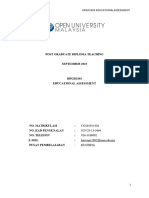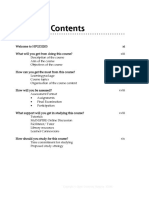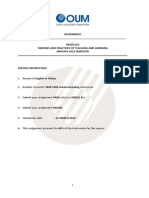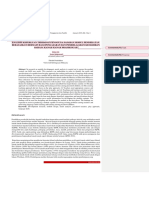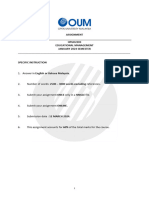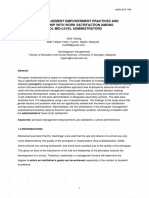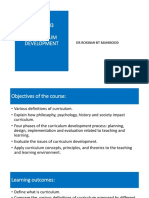0 ratings0% found this document useful (0 votes)
188 views02 Hpgd2303 Toc
02 Hpgd2303 Toc
Uploaded by
NUR FAIZAH BINTI ROSLAN STUDENTCopyright:
© All Rights Reserved
Available Formats
Download as PDF, TXT or read online from Scribd
02 Hpgd2303 Toc
02 Hpgd2303 Toc
Uploaded by
NUR FAIZAH BINTI ROSLAN STUDENT0 ratings0% found this document useful (0 votes)
188 views4 pagesCopyright
© © All Rights Reserved
Available Formats
PDF, TXT or read online from Scribd
Share this document
Did you find this document useful?
Is this content inappropriate?
Copyright:
© All Rights Reserved
Available Formats
Download as PDF, TXT or read online from Scribd
Download as pdf or txt
0 ratings0% found this document useful (0 votes)
188 views4 pages02 Hpgd2303 Toc
02 Hpgd2303 Toc
Uploaded by
NUR FAIZAH BINTI ROSLAN STUDENTCopyright:
© All Rights Reserved
Available Formats
Download as PDF, TXT or read online from Scribd
Download as pdf or txt
You are on page 1of 4
Table of Contents
Course Guide ixăxix
Course Assignment Guide xxiăxxv
Topic 1 Roles of Assessment in Teaching and Learning 1
1.1 Tests, Measurement, Evaluation and Assessment 2
1.2 Why Do We Assess? 5
1.3 General Principles of Assessment 10
1.4 Types of Assessment 11
1.4.1 Formative vs Summative Assessments 11
1.4.2 Norm-referenced vs Criterion-referenced 15
Tests
1.5 Current Trends in Assessment 17
Summary 19
Key Terms 19
Topic 2 Foundation for Assessment: What to Assess 20
2.1 What to Assess 21
2.2 Three Types of Learning Outcomes 22
2.3 Assessing Cognitive Learning Outcomes 24
2.4 Assessing Affective Outcomes 30
2.5 Assessing Psychomotor Learning Outcomes 35
Summary 40
Key Terms 41
Topic 3 Planning the Classroom Test 42
3.1 Purpose of Classroom Testing 43
3.2 Planning the Classroom Test 44
3.2.1 Deciding Its Purpose 44
3.2.2 Specifying the Learning Objectives 45
3.2.3 Developing Test Specifications 45
3.2.4 Selecting Best Item Types 49
3.2.5 Preparing Rubrics or Marking Schemes 50
3.2.6 Preparing Test Items 51
3.3 Assessing TeacherÊs Own Test 52
Summary 53
Key Terms 54
Copyright © Open University Malaysia (OUM)
iv TABLE OF CONTENTS
Topic 4 Constructing Objective Test Items 55
4.1 What is an Objective Test? 56
4.2 Short-answer Questions 57
4.3 True-false Questions 60
4.3.1 Limitations of True-false Questions 61
4.3.2 Suggestions for Construction of True-false Questions 62
4.4 Matching Questions 64
4.4.1 Advantages of Matching Questions 65
4.4.2 Limitations of Matching Questions 66
4.4.3 Suggestions for Writing Good Matching Questions 67
4.5 Multiple-choice Questions 68
4.5.1 Parts of a Multiple-choice Question 69
4.5.2 Construction of Multiple-choice Questions 70
4.5.3 Advantages and Limitations of MCQs 75
4.5.4 Constructing MCQs to Measure Higher-order 77
Thinking (HOT)
Summary 81
Key Terms 82
Topic 5 Constructing Essay Questions 83
5.1 What is an Essay Question? 84
5.2 Types of Essays 85
5.3 Why are Essay Questions Used? 86
5.4 Deciding Whether to Use Essay Or Objective Questions 87
5.5 Limitations of Essay Questions 88
5.6 Some Misconceptions about Essay Questions 89
5.7 Some Guidelines for Constructing Essay Questions 91
5.8 Verbs Describing Various Kinds of Mental Tasks 98
5.9 Marking Essay Questions 103
Summary 108
Key Terms 109
Topic 6 Authentic Assessments 110
6.1 What is Authentic Assessment? 111
6.1.1 Types of Authentic Assessments 112
6.1.2 Characteristics of Authentic Assessments 113
6.2 How to Create Authentic Assessments? 115
6.2.1 Advantages of Authentic Assessments 116
6.2.2 Criticisms of Authentic Assessments 117
6.3 Differences between Traditional Assessment and 118
Authentic Assessment
Copyright © Open University Malaysia (OUM)
TABLE OF CONTENTS v
6.4 Assessment Tools 121
6.4.1 Scoring Rubrics 122
6.4.2 Rating Scales 124
6.4.3 Checklists 126
Summary 127
Key Terms 127
Topic 7 Project and Portfolio Assessments 128
7.1 Project Assessment 129
7.1.1 Assessing Learners with Projects 132
7.1.2 Designing Effective Projects 135
7.1.3 Possible Problems with Project Work 138
7.1.4 Group Work in Projects 139
7.1.5 Assessing Project Work 140
7.1.6 Assessing Process in a Project 145
7.2 Portfolio Assessment 149
7.2.1 What is Portfolio Assessment? 150
7.2.2 Rationale for Portfolio Assessment 150
7.2.3 Types of Portfolios 151
7.2.4 How to Develop a Portfolio 152
7.2.5 Advantages and Disadvantages of Portfolio 153
Assessment
7.2.6 How and When Should a Portfolio be Assessed? 155
Summary 158
Key Terms 159
Topic 8 Test Reliability and Validity 160
8.1 What is Reliability? 160
8.2 The Reliability Coefficient 162
8.3 Methods to Estimate the Reliability of a Test 165
8.4 Inter-rater and Intra-rater Reliability 169
8.5 Types of Validity 171
8.6 Factors Affecting Reliability and Validity 175
8.7 Relationship between Reliability and Validity 176
Summary 178
Key Terms 179
Copyright © Open University Malaysia (OUM)
vi TABLE OF CONTENTS
Topic 9 Appraising Classroom Tests and Item Analysis 180
9.1 What is Item Analysis? 181
9.2 Steps in Item Analysis 181
9.3 The Difficulty Index 183
9.4 The Discrimination Index 185
9.5 Application of Item Analysis on Essay-type Question 188
9.6 Relationship between Difficulty Index and Discrimination 191
Index
9.7 Distractor Analysis 193
9.8 Practical Approach to Item Analysis 194
9.9 Usefulness of Item Analysis to Teachers 196
9.10 Cautions in Interpreting Item Analysis Results 198
9.11 Item Bank 199
9.12 Psychometric Softwares 200
Summary 201
Key Terms 202
Topic 10 Analysis and Interpretation of Test Scores 203
10.1 Why Do We Use Statistics? 204
10.2 Describing Test Scores 206
10.3 Standard Scores 214
10.4 The Normal Curve 218
Summary 219
Key Terms 220
References 221
Copyright © Open University Malaysia (OUM)
You might also like
- English Teaching Professional 74 May 2011Document68 pagesEnglish Teaching Professional 74 May 2011Kari AleNo ratings yet
- HPGD2303 Educational Assessment - Caug17 (Bookmark) PDFDocument249 pagesHPGD2303 Educational Assessment - Caug17 (Bookmark) PDFFauzi Azrin Md DaminNo ratings yet
- Assignment HPGD2203 Educational Management January 2023 Semester - Specific InstructionDocument10 pagesAssignment HPGD2203 Educational Management January 2023 Semester - Specific InstructionSITI RUHAIDA BINTI MUSTAFA STUDENTNo ratings yet
- Assignment HPGD1203 Theories and Practices of Teaching and Learning May Semester 2022Document6 pagesAssignment HPGD1203 Theories and Practices of Teaching and Learning May Semester 2022Syazliaty SyazNo ratings yet
- Assignment HMEF5023 - V2 Educational Leadership September 2021 SemesterDocument5 pagesAssignment HMEF5023 - V2 Educational Leadership September 2021 Semesternorasyikin0% (1)
- HPGD2303 Draft AssignmentDocument13 pagesHPGD2303 Draft AssignmentMuhammad Fakhrul Najmi JaafarNo ratings yet
- Postgraduate Diploma in Teaching: Matriculation No: Identity Card No.: Telephone No.: E-Mail: Learning CentreDocument24 pagesPostgraduate Diploma in Teaching: Matriculation No: Identity Card No.: Telephone No.: E-Mail: Learning CentreMuhammad Fakhrul Najmi Jaafar100% (3)
- Iroquois Clothes and WampumDocument3 pagesIroquois Clothes and Wampumapi-254323856No ratings yet
- Balaguer-Platonism and Anti-Platonism in Mathematics PDFDocument229 pagesBalaguer-Platonism and Anti-Platonism in Mathematics PDFNatia Lombardo100% (3)
- The Predicament of MankindDocument31 pagesThe Predicament of Mankindjim_iiNo ratings yet
- 04 HPGD2303 CGDocument12 pages04 HPGD2303 CGNUR FAIZAH BINTI ROSLAN STUDENTNo ratings yet
- HPGD2303 EducationalassessmentDocument36 pagesHPGD2303 Educationalassessmenterza wanyNo ratings yet
- Answers To Sample Questions To Paper 2.12Document9 pagesAnswers To Sample Questions To Paper 2.12RuhulHubbiNo ratings yet
- 04 HPGD2203 CGDocument9 pages04 HPGD2203 CGMuhammad Fakhrul Najmi JaafarNo ratings yet
- HPGD2203 CGS03243042Document19 pagesHPGD2203 CGS03243042syafiq19No ratings yet
- PGDTDocument13 pagesPGDTmuhammaducuk100% (1)
- Assignment QuestionDocument17 pagesAssignment QuestionNurulAfikaNo ratings yet
- Zulaikah HPGD1203Document18 pagesZulaikah HPGD1203zulaikahnadirah93No ratings yet
- 019 MaryamDocument7 pages019 MaryamIzatul AzmaNo ratings yet
- 2 Ocp Guide Learners January 2023Document8 pages2 Ocp Guide Learners January 2023MOHD SYUKRI BIN ABDUL WAHAB STUDENTNo ratings yet
- Postgraduate Diploma in TeachingDocument10 pagesPostgraduate Diploma in TeachingSAIYIDATUL SHUFWAH BINTI JABILIN STUDENTNo ratings yet
- Assignment HPGD3203 Emerging Technologies in Teaching and Learning May 2023 SemesterDocument23 pagesAssignment HPGD3203 Emerging Technologies in Teaching and Learning May 2023 SemesternurulNo ratings yet
- HPGD1203 Theories and Practices of Teaching and LearningDocument6 pagesHPGD1203 Theories and Practices of Teaching and LearningNUR FAIZAHNo ratings yet
- HPGD 2103 - Guidance and CounsellingDocument14 pagesHPGD 2103 - Guidance and CounsellingkhugeshNo ratings yet
- HPGD2203 Education ManagementDocument16 pagesHPGD2203 Education ManagementTce ShikinNo ratings yet
- 27th JULY 2020Document7 pages27th JULY 2020Muhammad Fakhrul Najmi JaafarNo ratings yet
- Em Contoh 2Document23 pagesEm Contoh 2afieqafariha1904No ratings yet
- PGDTDocument2 pagesPGDTMuhammad Fakhrul Najmi JaafarNo ratings yet
- Online Activity 1 (Marks - 10%) - Topic 1 - 5 - SecondDocument7 pagesOnline Activity 1 (Marks - 10%) - Topic 1 - 5 - SecondNUR AYUNI SEKOLAH SERI SEREMBANNo ratings yet
- Pendapat Dan Pandangan Pakar - Pakar Tentang Kurikulum-1Document26 pagesPendapat Dan Pandangan Pakar - Pakar Tentang Kurikulum-1Sulocana SheilaNo ratings yet
- Guidence and Caunselling Final ExamDocument6 pagesGuidence and Caunselling Final Examjalan sungaiNo ratings yet
- Assignment HPGD3203 Emerging Technologies in Teaching and Learning May 2022 SemesterDocument10 pagesAssignment HPGD3203 Emerging Technologies in Teaching and Learning May 2022 SemesterSyazliaty SyazNo ratings yet
- HPGD3203Document22 pagesHPGD3203nashaie98No ratings yet
- Analisis Keperluan Terhadap Pengguna Sasaran Modul Pendekatan Berasaskan Bermain Bagi Pengajaran Dan Pembelajaran Kemahiran Bahasa Kanak-Kanak PrasekolahDocument9 pagesAnalisis Keperluan Terhadap Pengguna Sasaran Modul Pendekatan Berasaskan Bermain Bagi Pengajaran Dan Pembelajaran Kemahiran Bahasa Kanak-Kanak Prasekolahhanie93No ratings yet
- Assignment Hpgd2103Document13 pagesAssignment Hpgd2103nurul amiraNo ratings yet
- Assignment Emerging Tech Sem 3Document27 pagesAssignment Emerging Tech Sem 3Nurasyikin Mohd NohNo ratings yet
- Assignment HPGD 2203 Educational Management September 2021 SemesterDocument7 pagesAssignment HPGD 2203 Educational Management September 2021 SemesterHaiqal FirdausNo ratings yet
- Education AssestmentDocument8 pagesEducation Assestmentaton hudaNo ratings yet
- Take Home Examination: HMEF5023Document14 pagesTake Home Examination: HMEF5023GOMATHI A/P CHELLIAH MoeNo ratings yet
- Em - Question Assignment - Jan 24Document9 pagesEm - Question Assignment - Jan 24afieqafariha1904No ratings yet
- Assignment HPGD2103Document4 pagesAssignment HPGD2103chs076 Maria AlkiftiahNo ratings yet
- Assignment HMEF5023 - V2 Educational Leadership September 2022 SemesterDocument7 pagesAssignment HMEF5023 - V2 Educational Leadership September 2022 SemesterTkah WahabNo ratings yet
- Assignment / Tugasan HPGD1203 Theories and Practices of Teaching and Learning January 2024 SemesterDocument10 pagesAssignment / Tugasan HPGD1203 Theories and Practices of Teaching and Learning January 2024 SemesterNUR AFIFAH BINTI JAMALUDIN STUDENT0% (1)
- Arahan AssignmentDocument20 pagesArahan AssignmentizzatiNo ratings yet
- MyINSPIRE Guide For StudentsDocument47 pagesMyINSPIRE Guide For StudentsKee CHNo ratings yet
- Assigment - Hmef5023v2 - Educational LeadershipDocument42 pagesAssigment - Hmef5023v2 - Educational LeadershipHanani Izzati100% (1)
- HPGD2303 Draft AssignmentDocument17 pagesHPGD2303 Draft AssignmentMuhammad Fakhrul Najmi JaafarNo ratings yet
- HPGD 3103 - ItDocument14 pagesHPGD 3103 - ItMuniraa MoonNo ratings yet
- ArtikelDocument14 pagesArtikelIzzah AnizanNo ratings yet
- Assignment HPGD3103 Instructional Technologies September 2022 Semester - Specific InstructionDocument12 pagesAssignment HPGD3103 Instructional Technologies September 2022 Semester - Specific InstructionTkah WahabNo ratings yet
- Open University MalaysiaDocument5 pagesOpen University MalaysiaAiman YatimNo ratings yet
- Soalan Assignment emDocument9 pagesSoalan Assignment emafieqafariha1904No ratings yet
- Assignment HPGD3103 Instructional Technologies May 2021 SemesterDocument6 pagesAssignment HPGD3103 Instructional Technologies May 2021 SemesterANIS SYAHMI BINTI MOHD ASRINo ratings yet
- Soalan Assignment HPGD3103 May 2020Document7 pagesSoalan Assignment HPGD3103 May 2020chs076 Maria AlkiftiahNo ratings yet
- Take Home Examination - Hmef5023 - v2 Leong Yen XinDocument12 pagesTake Home Examination - Hmef5023 - v2 Leong Yen XinLeongYenXin100% (2)
- 1.0 Question 1: Critical Review 1.1 Article 1Document22 pages1.0 Question 1: Critical Review 1.1 Article 1Muhammad Fakhrul Najmi JaafarNo ratings yet
- Educational Assesment Final ExamDocument13 pagesEducational Assesment Final ExamNrsma HakimNo ratings yet
- 27th JULY 2020Document4 pages27th JULY 2020RuhulHubbiNo ratings yet
- Hmef 5023Document13 pagesHmef 5023alexiusbiraiNo ratings yet
- Exam QuestionDocument8 pagesExam QuestionShiyamala SubramaniamNo ratings yet
- HPGD4606 Practicum Postgraduate Diploma in TeachingDocument15 pagesHPGD4606 Practicum Postgraduate Diploma in TeachingNUR FAIZAH BINTI ROSLAN STUDENTNo ratings yet
- HPGD3103 - Instructional TechnologyDocument16 pagesHPGD3103 - Instructional TechnologyMuniraa MoonNo ratings yet
- HPGD2303 Educational Assessment - Esept21 (CS)Document255 pagesHPGD2303 Educational Assessment - Esept21 (CS)ANISAH BINTI ISMAIL STUDENTNo ratings yet
- 02 Hbet4503 TocDocument4 pages02 Hbet4503 TocTce ShikinNo ratings yet
- Scheme of Work March 2018Document6 pagesScheme of Work March 2018NUR FAIZAH BINTI ROSLAN STUDENTNo ratings yet
- HPGD4606 Practicum Postgraduate Diploma in TeachingDocument15 pagesHPGD4606 Practicum Postgraduate Diploma in TeachingNUR FAIZAH BINTI ROSLAN STUDENTNo ratings yet
- Problem-Based Learning Vs Project-Based LearningDocument13 pagesProblem-Based Learning Vs Project-Based LearningNUR FAIZAH BINTI ROSLAN STUDENTNo ratings yet
- Cooperative Learning and How To Use It in The ClassroomDocument4 pagesCooperative Learning and How To Use It in The ClassroomNUR FAIZAH BINTI ROSLAN STUDENTNo ratings yet
- 06 HPGD2303 Course Assignment GuideDocument6 pages06 HPGD2303 Course Assignment GuideNUR FAIZAH BINTI ROSLAN STUDENTNo ratings yet
- Lecture 1 Hpgd1103 E-Tutorial Part1 May 2021Document28 pagesLecture 1 Hpgd1103 E-Tutorial Part1 May 2021NUR FAIZAH BINTI ROSLAN STUDENTNo ratings yet
- Transactional Vs Transformational LeadershipDocument18 pagesTransactional Vs Transformational LeadershipNUR FAIZAH BINTI ROSLAN STUDENTNo ratings yet
- 20 Big Communication MistakeDocument19 pages20 Big Communication MistakeNUR FAIZAH BINTI ROSLAN STUDENTNo ratings yet
- Quality Management in EducationDocument15 pagesQuality Management in EducationNUR FAIZAH BINTI ROSLAN STUDENTNo ratings yet
- Q1 Activities in HGP 7Document1 pageQ1 Activities in HGP 7Armylyn Garcia Almerol EsperanzaNo ratings yet
- Critical Incident Stress DebriefingDocument20 pagesCritical Incident Stress DebriefingatenampNo ratings yet
- Thomas Green at Dynamic DisplayDocument7 pagesThomas Green at Dynamic DisplayBharat DalviNo ratings yet
- An Educational Approach To Elementary School Students' Free TimeDocument33 pagesAn Educational Approach To Elementary School Students' Free TimeplavaadresaNo ratings yet
- Opinion Essay Marking SchemeDocument1 pageOpinion Essay Marking SchemeBianca MocanuNo ratings yet
- Social Learning Theory (A. Bandura) : OverviewDocument14 pagesSocial Learning Theory (A. Bandura) : Overviewbabab18100% (1)
- (English Course) BBC - British Council Teaching English - Literature - Storytelling - Benefits and TipsDocument5 pages(English Course) BBC - British Council Teaching English - Literature - Storytelling - Benefits and TipsclolteanuNo ratings yet
- Tuesday 14 January 2020: English Language ADocument28 pagesTuesday 14 January 2020: English Language ANoël PereraNo ratings yet
- Part I Chapter 4Document4 pagesPart I Chapter 4Joshua SolayaoNo ratings yet
- Tarea Cora Diamond - Eating Meat and Eating PeopleDocument1 pageTarea Cora Diamond - Eating Meat and Eating PeopleEduardo J. HorabuenaNo ratings yet
- The Business Concerns For Artists To Present A New SongDocument3 pagesThe Business Concerns For Artists To Present A New Songdiana fonsecaNo ratings yet
- Guidelines and Rubric in Writing SpeechDocument3 pagesGuidelines and Rubric in Writing SpeechMonica GeronaNo ratings yet
- Essay On Nonverbal Communication in ClassroomDocument30 pagesEssay On Nonverbal Communication in ClassroomZdeslav Hrepic100% (2)
- Lesson 1 ModuleDocument4 pagesLesson 1 ModuleAkira EunHee100% (1)
- DLL 11CGP W1 4 Q2Document4 pagesDLL 11CGP W1 4 Q2Joewellyn LimNo ratings yet
- AMT 4101 Aircraft Structure 1Document17 pagesAMT 4101 Aircraft Structure 1Nahshon YbanezNo ratings yet
- Decision Trees in Managerial Decision MakingDocument5 pagesDecision Trees in Managerial Decision MakingAugustineNo ratings yet
- Building and Enhancing New Literacies Across The Curriculum in The 21 Century SkillsDocument3 pagesBuilding and Enhancing New Literacies Across The Curriculum in The 21 Century SkillsJudie Lee TandogNo ratings yet
- Lesson PlanDocument7 pagesLesson PlanChisnaNo ratings yet
- Educ 310 Math Unit Plan Evaluation AssessmentDocument2 pagesEduc 310 Math Unit Plan Evaluation Assessmentapi-696995737No ratings yet
- BP B1 Tests Unit1Document3 pagesBP B1 Tests Unit1kategotsulenko2005No ratings yet
- Research Article: A Hybrid Classification System For Heart Disease Diagnosis Based On The RFRS MethodDocument11 pagesResearch Article: A Hybrid Classification System For Heart Disease Diagnosis Based On The RFRS MethodYassine MalehNo ratings yet
- Annotated Bibliography AssignmentDocument2 pagesAnnotated Bibliography Assignmentapi-361745672No ratings yet
- 1341 Recruitment and Selection: Required Text: V.M. Catano, W.H. Wiesner, R.D. Hackett. Recruitment and Selection inDocument9 pages1341 Recruitment and Selection: Required Text: V.M. Catano, W.H. Wiesner, R.D. Hackett. Recruitment and Selection inShafa AlasgarovaNo ratings yet
- Sentential Relative and Supplementive ClausesDocument2 pagesSentential Relative and Supplementive ClausesPetra BajacNo ratings yet
- Ed 242 - Bella Roumain Social Imagination Write UpDocument4 pagesEd 242 - Bella Roumain Social Imagination Write Upapi-577072772No ratings yet











